Potřebujeme váš souhlas k využití jednotlivých dat, aby se vám mimo jiné mohly ukazovat informace týkající se vašich zájmů. Souhlas udělíte kliknutím na tlačítko „OK“.
ASTM E1922-04(2010)e1
Standard Test Method for Translaminar Fracture Toughness of Laminated and Pultruded Polymer Matrix Composite Materials (Includes all amendments And changes 7/31/2015).
Automaticky přeložený název:
Standardní zkušební metoda pro Translaminární lomové houževnatosti z laminovaných a tažené polymerních kompozitních materiálů
NORMA vydána dne 1.10.2010
Informace o normě:
Označení normy: ASTM E1922-04(2010)e1
Poznámka: NEPLATNÁ
Datum vydání normy: 1.10.2010
Kód zboží: NS-43604
Počet stran: 5
Přibližná hmotnost: 15 g (0.03 liber)
Země: Americká technická norma
Kategorie: Technické normy ASTM
Anotace textu normy ASTM E1922-04(2010)e1 :
Keywords:
translaminar fractur toughness, laminated polymer, pultruded polymer, matrix composite, ICS Number Code 83.140.20 (Laminated sheets)
Doplňující informace
| Significance and Use | ||||||||||||||||||||
|
The parameter KTL determined by this test method is a measure of the resistance of a polymer matrix composite laminate to notch-tip damage and effective translaminar crack growth under opening mode loading. The result is valid only for conditions in which the damage zone at the notch tip is small compared with the notch length and the in-plane specimen dimensions. This test method can serve the following purposes. In research and development, KTL data can quantitatively establish the effects of fiber and matrix variables and stacking sequence of the laminate on the translaminar fracture resistance of composite laminates. In acceptance and quality control specifications, KTL data can be used to establish criteria for material processing and component inspection. The translaminar fracture toughness, KTL, determined by this test method may be a function of the testing speed and temperature. This test method is intended for room temperature and quasi-static conditions, but it can apply to other test conditions provided that the requirements of 9.2 and 9.3 are met. Application of KTL in the design of service components should be made with awareness that the test parameters specified by this test may differ from service conditions, possibly resulting in a different material response than that seen in service. Not all types of laminated polymer matrix composite materials experience the contained notch-tip damage and effective translaminar crack growth of concern in this test method. For example, the notch-tip damage may be more extensive and may not be accompanied by any significant amount of effective translaminar crack growth. Typically, lower strength composite materials and those with a significant proportion of reinforcing fibers aligned in a direction perpendicular to the notch axis may not experience the contained notch-tip damage required for a valid test. |
||||||||||||||||||||
| 1. Scope | ||||||||||||||||||||
|
1.1 This test method covers the determination of translaminar fracture toughness, KTL, for laminated and pultruded polymer matrix composite materials of various ply orientations using test results from monotonically loaded notched specimens. 1.2 This test method is applicable to room temperature laboratory air environments. 1.3 Composite materials that can be tested by this test method are not limited by thickness or by type of polymer matrix or fiber, provided that the specimen sizes and the test results meet the requirements of this test method. This test method was developed primarily from test results of various carbon fiber – epoxy matrix laminates and from additional results of glass fiber – epoxy matrix, glass fiber-polyester matrix pultrusions and carbon fiber – bismaleimide matrix laminates (1-4, 6, 7). 1.4 A range of eccentrically loaded, single-edge-notch tension, ESE(T), specimen sizes with proportional planar dimensions is provided, but planar size may be variable and adjusted, with associated changes in the applied test load. Specimen thickness is a variable, independent of planar size. 1.5 Specimen configurations other than those contained in this test method may be used, provided that stress intensity calibrations are available and that the test results meet the requirements of this test method. It is particularly important that the requirements discussed in 5.1 and 5.4 regarding contained notch-tip damage be met when using alternative specimen configurations. 1.6 The values stated in SI units are to be regarded as standard. No other units of measurement are included in this standard. 1.7 This standard does not purport to address all of the safety concerns, if any, associated with its use. It is the responsibility of the user of this standard to establish appropriate safety and health practices and to determine the applicability of regulatory limitations prior to use. |
||||||||||||||||||||
| 2. Referenced Documents | ||||||||||||||||||||
|
Doporučujeme:
EviZak - všechny zákony včetně jejich evidence na jednom místě
Poskytování aktuálních informací o legislativních předpisech vyhlášených ve Sbírce zákonů od roku 1945.
Aktualizace 2x v měsíci !
Chcete vědět více informací? Podívejte se na tuto stránku.




 Cookies
Cookies
